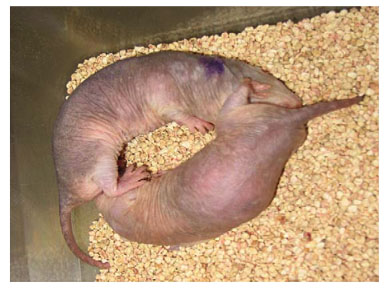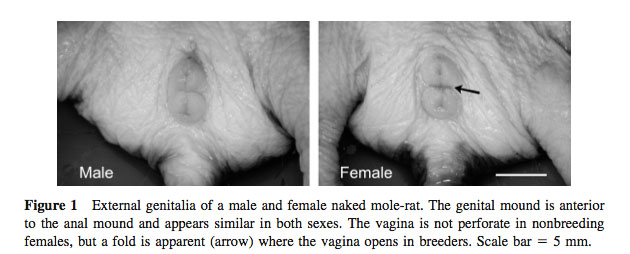The Naked Mole-Rat
Biology 342 Fall 08 -- Holly Cho and Patricia Snarski
Ontogeny
Such a strict hierarchy is going to be difficult to maintain and so naked mole rats have evolved many different characteristics, morphologically, hormonally, and behaviorally. Researchers have found that while all adult naked mole-rats are capable of breeding, subordinates only engage in good old sexy time when not being regulated through social cues created by the dominant pair.
Behavior
Naked mole-rats are remarkably sexually monomorphic, especially subordinate males and females. Most rodents have very stereotypic sexual morphisms. Female rodents typically enter a position called lordosis when ready to mate, which includes arching her back and lifting her genitalia into the air so the male can mount her and enter into intromission.
However, subordinate mole-rats do not engage in typical lordosis behaviors. Nor do they engage in a behavior called genital nuzzling that it is initiated by eithermember of a breeding pair.

In an experiment by Sherry Goldman et al, the authors report that weeks after both breeding mole-rats had their gonads removed, there were instances of subordinate nuzzling, which imply that there is some hormonal control in reproductive stagnancy (8). This behavior reinforces the status of the breeding pair as dominant for no lordosis or mounting was observed in the subordinates that did engage in nuzzling.
For more information, see the Mechanism page.
Hormones
In most social groups, the dominant members have a higher concentration of cortisol in their plasma over subordinate members. The cortisol relates to stress, and the dominant members of a social group are more aggressive. Naked mole-rats are no different. Gonadotropins also follow the same path. Baseline levels of estrodiol and progesterone in females and testosterone in males is higher in dominant mole-rats than the subordinate (5, 8, 10).
Rodents are known for their remarkable responsiveness to gonadotropins during their fetal development and their sexually dimorphic shifts in physiology and behavior. Unfortunately, no studies to date have been performed on naked mole-rats to see how different levels of hormones affect their development, but it is known that typical dimorphic changes in the brain that are found between the sexes found in other rodents doesn’t appear in naked mole-rats until they shift into reproductive mode (10). These brain differences are caused by gonadotropins so it isn’t clear how gonadotropins function in naked mole-rat fetuses to differentiate between males and females but not enact the other typical changes found in other rodents (10).
To learn more, see the Mechanism page
Morphology
Since extremes always like to congregate, the extent to the lack of sexual dimorphism is amazing as well. Studies show that not only is there barely any external genital differentiation between the sexes in subordinate individuals, internally, there is no significant difference between males and females as well. Most rodents have distinct differences in the motornerurons in the striated perennial muscles that make up the penis or clitoris. In H. glaber, there is no such difference. There is, however, distinct differences in gross dissection, so subordinate mole-rats are capable of sexual reproduction if such a situation arises (13).
Naked mole-rat brains are also remarkably monomorphic. In fact, the researchers have concluded that social status affects morphological changes in the brain more than sex does for the majority of individuals in naked mole-rat societies (10).
To learn more, see the Mechanism page.